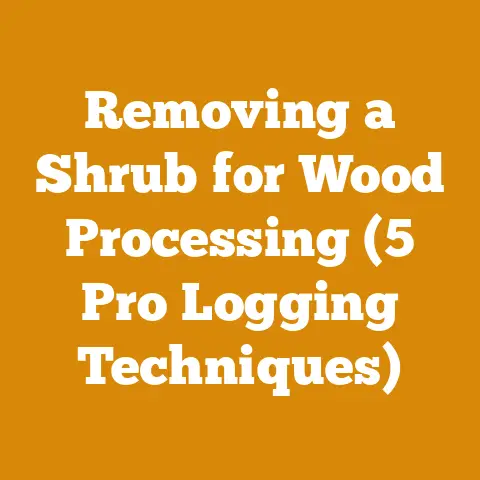How to Put Fire Bricks in a Wood Burner (5 Pro Tips for Efficiency)
Introduction
As someone who’s spent countless hours around wood stoves, I’ve learned firsthand the importance of maintaining their efficiency and longevity. One crucial aspect that often gets overlooked is the condition of the fire bricks. Wear and tear on these bricks is inevitable – the constant exposure to intense heat and thermal cycling takes its toll. Over time, fire bricks can crack, crumble, or even completely disintegrate. This not only reduces the stove’s efficiency but can also pose a safety hazard. Replacing them is a straightforward task that can significantly improve your stove’s performance, extend its lifespan, and ensure safer operation. In this guide, I’ll share my experience and five pro tips to help you put fire bricks in your wood burner efficiently and correctly, so you can get back to enjoying a warm and cozy home.
How to Put Fire Bricks in a Wood Burner: 5 Pro Tips for Efficiency
1. Preparation and Assessment: Laying the Groundwork
Before you even think about touching a fire brick, a thorough assessment of your wood stove is essential. Understanding the existing layout and the extent of the damage will save you time and prevent future headaches.
- Safety First: Always ensure the stove is completely cool before starting any work. Disconnect it from the chimney if possible, or at least ensure the damper is closed to prevent soot or debris from falling into your workspace.
- Document the Existing Layout: Take photos or draw a diagram of how the old fire bricks are arranged. This is crucial because different stove models use various brick layouts. A picture is worth a thousand words, especially when you are trying to remember the configuration later.
- Inventory and Damage Assessment: Carefully remove the old fire bricks, noting their size and shape. Pay close attention to any special cuts or angles. Count the number of each type of brick you remove. This will form your shopping list. Assess the firebox itself. Look for any signs of damage to the stove’s metal components, such as cracks or warping. Address these issues before installing new bricks.
-
Cleaning the Firebox: Once the old bricks are removed, thoroughly clean the firebox. Use a wire brush and a shop vacuum to remove any loose debris, soot, or ash. A clean surface will help the new bricks sit properly and ensure good contact.
- Personal Story: I once skipped the cleaning step and ended up with uneven brick placement, which led to less efficient burning. Now, I always make sure the firebox is spotless before starting.
-
Tool List: Gather the necessary tools:
- Gloves: Protect your hands from sharp edges and soot.
- Safety Glasses: Prevent debris from getting into your eyes.
- Wire Brush: For cleaning the firebox.
- Shop Vacuum: To remove loose debris.
- Measuring Tape: For confirming brick dimensions.
- Chisel and Hammer (Optional): For trimming bricks if needed.
- Refractory Mortar (Optional): For securing bricks in place.
-
Brick Specifications: Fire bricks typically come in standard sizes, such as 9 x 4.5 x 1.25 inches. However, your stove may require custom sizes. Refer to your stove’s manual or measure the old bricks to determine the correct dimensions. If you need to cut bricks, use a masonry saw or a brick chisel and hammer.
-
Data Point: Using the wrong size fire brick can reduce the stove’s efficiency by as much as 20%.
-
Disposal of Old Bricks: Check local regulations for disposing of old fire bricks. In some areas, they can be disposed of with regular construction waste. In others, they may need to be taken to a specialized recycling center.
- Takeaway: Proper preparation is the foundation of a successful fire brick replacement. It ensures you have the right materials, a clean workspace, and a clear understanding of the task ahead.
2. Selecting the Right Fire Bricks: Material Matters
Choosing the right fire bricks is crucial for the performance and longevity of your wood stove. Not all bricks are created equal, and understanding the different types and their properties is essential.
-
Types of Fire Bricks:
- Standard Fire Bricks: These are the most common type, made from fireclay and designed to withstand high temperatures. They are suitable for most wood stoves.
- High-Alumina Fire Bricks: These bricks contain a higher percentage of alumina, making them more resistant to thermal shock and higher temperatures. They are ideal for stoves that experience frequent temperature fluctuations or burn very hot.
- Insulating Fire Bricks: These bricks are less dense and provide better insulation, helping to keep the heat inside the firebox. However, they are not as durable as standard or high-alumina bricks and are best used in specific areas of the stove, as recommended by the manufacturer.
-
Material Properties:
-
Thermal Conductivity: This measures how well the brick conducts heat. Lower thermal conductivity is desirable for fire bricks, as it helps to keep the heat inside the firebox.
- Thermal Shock Resistance: This measures the brick’s ability to withstand sudden temperature changes without cracking. High thermal shock resistance is crucial for wood stoves that experience rapid heating and cooling cycles.
- Compressive Strength: This measures the brick’s ability to withstand pressure. Higher compressive strength is important for bricks that support the weight of the fuel or other stove components.
-
Matching the Brick to the Stove:
-
Consult the Stove Manual: The stove’s manual will typically specify the type and dimensions of fire bricks required. Always follow the manufacturer’s recommendations.
- Consider Your Burning Habits: If you frequently burn very hot fires, high-alumina bricks may be a better choice. If you are primarily concerned with heat retention, insulating fire bricks may be suitable for certain areas of the stove.
-
Sourcing Quality Bricks:
-
Local Fireplace Stores: These stores typically carry a range of fire bricks and can offer expert advice.
- Online Retailers: Online retailers offer a wide selection of fire bricks, often at competitive prices. Be sure to check reviews and ratings before making a purchase.
-
Masonry Supply Stores: These stores specialize in masonry products and typically carry high-quality fire bricks.
-
Personal Story: I once bought cheap fire bricks online and regretted it. They cracked within a few months. Now, I only buy from reputable suppliers.
-
Cost Considerations: Standard fire bricks are generally the most affordable, while high-alumina and insulating fire bricks are more expensive. Consider your budget and the specific needs of your stove when making your selection.
-
Brick Dimensions and Tolerances:
- Standard Sizes: Common fire brick sizes include 9 x 4.5 x 1.25 inches, 9 x 4.5 x 2.5 inches, and 9 x 3 x 1.25 inches.
- Tolerances: Fire bricks may have slight variations in dimensions. Check the specifications to ensure they meet your stove’s requirements.
- Takeaway: Selecting the right fire bricks is a critical step in ensuring the efficiency, safety, and longevity of your wood stove. Consider the type of brick, its material properties, and your burning habits when making your selection.
3. Cutting and Shaping Fire Bricks: Precision is Key
Sometimes, standard-sized fire bricks won’t fit perfectly into your wood stove. In these cases, you’ll need to cut or shape the bricks to ensure a proper fit. This requires precision and the right tools.
-
When Cutting is Necessary:
- Custom Stove Designs: Some stoves have unique firebox shapes that require custom-cut bricks.
- Repairs and Modifications: If you’re repairing a damaged area or modifying the stove’s design, you may need to cut bricks to fit.
- Tight Spaces: In some cases, even standard-sized bricks may need to be trimmed to fit into tight spaces.
-
Tools for Cutting Fire Bricks:
-
Masonry Saw: This is the most efficient tool for cutting fire bricks. It uses a diamond blade to make clean, precise cuts.
- Brick Chisel and Hammer: This is a more manual method, but it can be effective for making small cuts or shaping bricks.
- Angle Grinder with Diamond Blade: An angle grinder with a diamond blade can be used for cutting and shaping fire bricks. However, it can be more difficult to control than a masonry saw.
-
Cutting Techniques:
-
Measuring and Marking: Accurately measure the area where the brick will be placed and mark the cutting line on the brick. Use a pencil or marker that is visible on the brick surface.
- Cutting with a Masonry Saw: Place the brick on the saw’s cutting table and align the cutting line with the blade. Slowly and steadily push the brick through the blade, keeping it firmly in place.
- Cutting with a Brick Chisel and Hammer: Place the brick on a solid surface and position the chisel along the cutting line. Strike the chisel firmly with the hammer, working your way along the line.
- Safety Precautions: Always wear safety glasses and gloves when cutting fire bricks. Use a dust mask to protect yourself from silica dust. Work in a well-ventilated area.
-
Shaping Techniques:
-
Rounding Edges: Use a brick chisel and hammer or an angle grinder to round off sharp edges. This can help the bricks fit more smoothly into the firebox.
-
Creating Angles: Use a masonry saw or a brick chisel and hammer to create angled cuts. This may be necessary for fitting bricks around corners or other stove components.
-
Personal Story: I once tried to cut a fire brick with a regular wood saw. It was a disaster! The blade was ruined, and the brick barely had a scratch. I learned my lesson: use the right tool for the job.
-
Fitting and Adjusting:
- Dry Fit: Before permanently installing the bricks, dry fit them into the firebox to ensure they fit properly. Make any necessary adjustments before proceeding.
- Gaps and Spacing: Aim for tight-fitting bricks with minimal gaps. Small gaps can be filled with refractory mortar.
-
Refractory Mortar:
-
Purpose: Refractory mortar is a heat-resistant mortar used to bond fire bricks together. It can help to seal gaps and prevent air leaks.
- Application: Apply a thin layer of refractory mortar to the edges of the bricks before placing them in the firebox.
- Curing: Allow the mortar to cure according to the manufacturer’s instructions before using the stove.
- Takeaway: Cutting and shaping fire bricks requires precision and the right tools. Take your time, measure carefully, and always prioritize safety.
4. Installation Techniques: Ensuring a Secure Fit
The way you install the fire bricks is just as crucial as selecting the right ones. A secure and proper fit ensures optimal heat retention and protects the stove’s metal components.
-
Following the Original Layout:
- Reference Your Documentation: Use the photos or diagrams you took during the removal process to guide your installation.
- Start with Key Bricks: Begin by placing the bricks that are most critical to the stove’s structural integrity or heat distribution. These may include bricks around the firebox opening or those that support the fuel.
-
Brick Placement:
-
Tight Fit: Aim for a tight fit between the bricks. This will minimize air leaks and maximize heat retention.
- Staggered Joints: If possible, stagger the joints between the bricks. This will create a stronger and more stable structure.
- Leveling: Ensure that the bricks are level and even. Use a level to check your work as you go.
-
Using Refractory Mortar:
-
When to Use: Refractory mortar is recommended for stoves that experience high temperatures or have loose-fitting bricks. It can also be used to seal gaps and prevent air leaks.
- Application: Apply a thin layer of refractory mortar to the edges of the bricks before placing them in the firebox. Press the bricks firmly into place to ensure good contact.
- Cleanup: Wipe away any excess mortar with a damp cloth.
-
Securing Bricks:
-
Metal Clips or Brackets: Some stoves use metal clips or brackets to secure the fire bricks in place. Make sure these are properly installed.
-
Gravity and Friction: In many cases, the bricks are held in place by gravity and friction. Ensure that the bricks are tightly packed and supported by the stove’s structure.
-
Personal Story: I once installed fire bricks without using refractory mortar, and they started shifting after a few burns. Now, I always use mortar to ensure a secure fit.
-
Addressing Gaps:
- Small Gaps: Small gaps can be filled with refractory mortar.
- Large Gaps: Large gaps may indicate that the bricks are not the right size or shape. Consider cutting or shaping the bricks to fit properly.
-
Checking for Stability:
-
Visual Inspection: After installing the bricks, visually inspect them to ensure they are stable and properly aligned.
- Gentle Pressure: Apply gentle pressure to the bricks to check for movement. If any bricks are loose, remove them and reinstall them.
-
Curing the Mortar:
-
Follow Instructions: Allow the refractory mortar to cure according to the manufacturer’s instructions before using the stove. This typically involves allowing the mortar to air dry for 24-48 hours.
- Slow Burn: After the mortar has cured, start with a small fire to gradually heat up the stove. This will help to prevent cracking.
- Takeaway: Proper installation techniques are essential for ensuring a secure and efficient fire brick installation. Follow the original layout, aim for a tight fit, and use refractory mortar when necessary.
5. Post-Installation and Maintenance: Long-Term Care
Once your new fire bricks are installed, proper post-installation care and regular maintenance will ensure they last for years to come.
-
Initial Burn-In:
- Purpose: The initial burn-in helps to cure the refractory mortar and allows the fire bricks to adjust to the heat.
- Procedure: Start with a small fire and gradually increase the size over several hours. Avoid burning a large, hot fire during the initial burn-in.
- Monitoring: Monitor the bricks for any signs of cracking or movement during the burn-in.
-
Regular Inspections:
-
Frequency: Inspect the fire bricks at least once a month during the heating season.
- What to Look For: Check for cracks, chips, or other signs of damage. Also, look for any signs of shifting or movement.
-
Cleaning and Maintenance:
-
Ash Removal: Regularly remove ash from the firebox. Excessive ash buildup can damage the fire bricks.
- Soot Removal: Clean the fire bricks with a wire brush to remove soot buildup.
- Repairing Cracks: Small cracks can be repaired with refractory mortar. Clean the area around the crack and apply a thin layer of mortar.
-
Preventative Measures:
-
Proper Fuel: Burn only dry, seasoned wood. Wet or green wood can create excessive creosote buildup, which can damage the fire bricks.
- Avoid Overloading: Avoid overloading the firebox with fuel. This can create excessive heat and stress on the fire bricks.
-
Airflow Control: Properly adjust the stove’s airflow to ensure efficient combustion. Insufficient airflow can lead to incomplete combustion and creosote buildup.
-
Personal Story: I neglected my fire bricks for a couple of years, and they ended up crumbling. Now, I make it a point to inspect them regularly and address any issues promptly.
-
Replacing Damaged Bricks:
- When to Replace: Replace any fire bricks that are severely cracked, chipped, or crumbling.
- Procedure: Follow the same steps as the initial installation, ensuring that the new bricks are properly fitted and secured.
-
Long-Term Care Tips:
-
Protect from Moisture: Keep the stove dry during the off-season to prevent moisture damage.
- Store Extra Bricks: Store a few extra fire bricks in a dry place for future repairs.
- Consult a Professional: If you are unsure about any aspect of fire brick maintenance, consult a qualified stove technician.
- Takeaway: Post-installation care and regular maintenance are essential for prolonging the life of your fire bricks and ensuring the efficient operation of your wood stove. Inspect the bricks regularly, clean them properly, and address any issues promptly.
Conclusion: Enjoying a Warm and Efficient Fire
Replacing fire bricks in a wood-burning stove is a manageable task that significantly impacts the stove’s performance, safety, and lifespan. By following these five pro tips – thorough preparation, selecting the right bricks, precise cutting and shaping, secure installation, and diligent post-installation care – you can ensure your wood stove operates efficiently and safely for years to come. Through my experience, I’ve learned that taking the time to do the job right pays off in the long run, providing a warm and cozy home throughout the colder months. Remember to always prioritize safety, consult your stove’s manual, and don’t hesitate to seek professional help when needed. With these insights, you’re well-equipped to tackle this maintenance task and enjoy the warmth and comfort of a well-maintained wood-burning stove.






